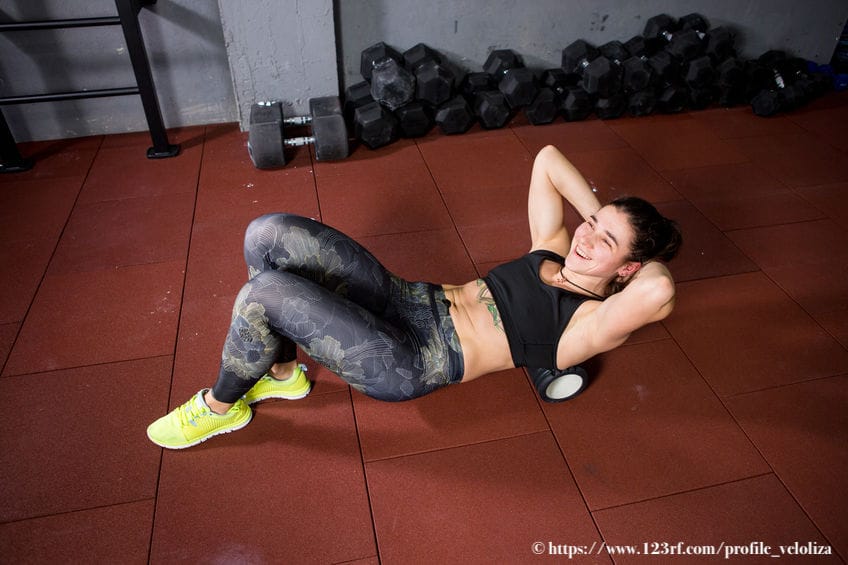In the last blog post I covered Self Myofascial Release (SMFR) techniques for the lower body in Sooth Your Muscle Tension with Foam Rolling Part 1. This post I will focus on SMFR techniques for the upper body. All the same important points apply: good form/body engagement, breathing, the Do’s & Don’ts, Benefits and the tools you’ll use. If you need a reminder check out the info in Part 1.
Let’s dive right in.
Upper Body
- Back (upper and mid) with a Peanut: You can use the foam roller or the peanut for this area of your back. When using the peanut, place it on your mid back just below your shoulder blades. The 2 tennis balls within the peanut should rest on either side of your spine. If you have never done any Self Myofascial Release work before, I wouldn’t recommend starting with using the peanut on your back, this is because it is hard to moderate how much of your body weight is weighted onto the peanut while rolling. But once you get used to rolling, I highly recommend it! Back to using the peanut on your back muscles….once you have the peanut in place, hug your arms across your chest and push into your feet to slowly roll the peanut up your spine to just below neck. Do 2-3 rolls up and down and then hug the other arm on top and roll another 2-3 times. Other arm options for this are hands behind the head holding the weight of your head as you roll up and down.
- Back (upper and mid) with the Foam Roller: When using the foam roller, hug your arms across your chest and tilt your body at a very slight angle so that the foam roller is moving over the musculature just next to the spine and not directly over the spine. Roll the same area, from just below your shoulder blades to just below your neck-the length of your shoulder blade. Then switch which arm is crossed on top and do the musculature on the other side of your spine. Keep the back a little bit curled when performing this SMFR technique.
- Lats: This is still part of your back, but it’s also a bit of the side of your torso. It’s the area under your armpit. You’ll lie on the foam roller and then tip your torso to the side. When using SMFR on this area make sure to roll only to just above your floating ribs or the spot that corresponds with the base of your shoulder blades. This ensures you don’t roll over any bones and has you staying with the meaty part of your Lat. You can roll up and down, but I also like to start with the roller just below my armpit an tilt side to side.
- More options for lats: This area can also be rolled with a tennis ball. It can be done standing against a wall or lying on the ground. Lying would be more intense, so if you are new to SMFR techniques your may want to start standing against a wall. Using the tennis ball can also help get into some of the rotator cuff muscles and really pin point some of the small areas of tightness.
- Pecs: You can use the foam roller or a tennis ball, with a tennis ball you can roll against the wall (video here). Place the ball just below the the front of your shoulder. Roll in a diagonally motion from near your shoulder towards your sternum (breast bone). You can also do a bit of rolling in front of your armpit. Be careful not to go into the armpit. It has a big nerve bundle (your brachial plexus) close by and you don’t want to roll over it with the ball or the foam roller. If you do you’ll know it, it’ll feel nerve-y or zing-y. If you do accidentally roll over the nerve bundle, that’s ok, but you don’t want to continually roll over it. Using the foam roller for this area is done by lying on the floor.
- Upper Trapezius: Using the tennis ball, you can use it in two separate places on your upper trap. First you can lean against the wall or floor with the ball to one side of your spine and move your body from side to side to roll from near your spine out towards the top of your shoulder-staying with the muscles and not rolling over the spine of the shoulder blade or any other bones. Another way to SMFR the traps is to on the top of your shoulder-in the meaty part near your neck and lean into a door frame. This would be a bit more sustained pressure in that area then rolling the ball around.
As always, if you have any questions please do not hesitate to leave a comment or contact us. If you liked this post feel free to leave a comment saying so or share it with a friend.
Happy rolling! ~Theresa


Pingback: Are You Doing This Stretch Correctly? – Redefine Strength & Fitness
Pingback: Soothe Your Muscle Tension with Foam Rolling-Part 1 – Redefine Strength & Fitness
Pingback: Straddle Splits and a Straddle Pancake. (part 2) - Redefine Strength & Fitness
Pingback: Soothe Your Muscle Tension with Foam Rolling-Part 1 - Reimagym